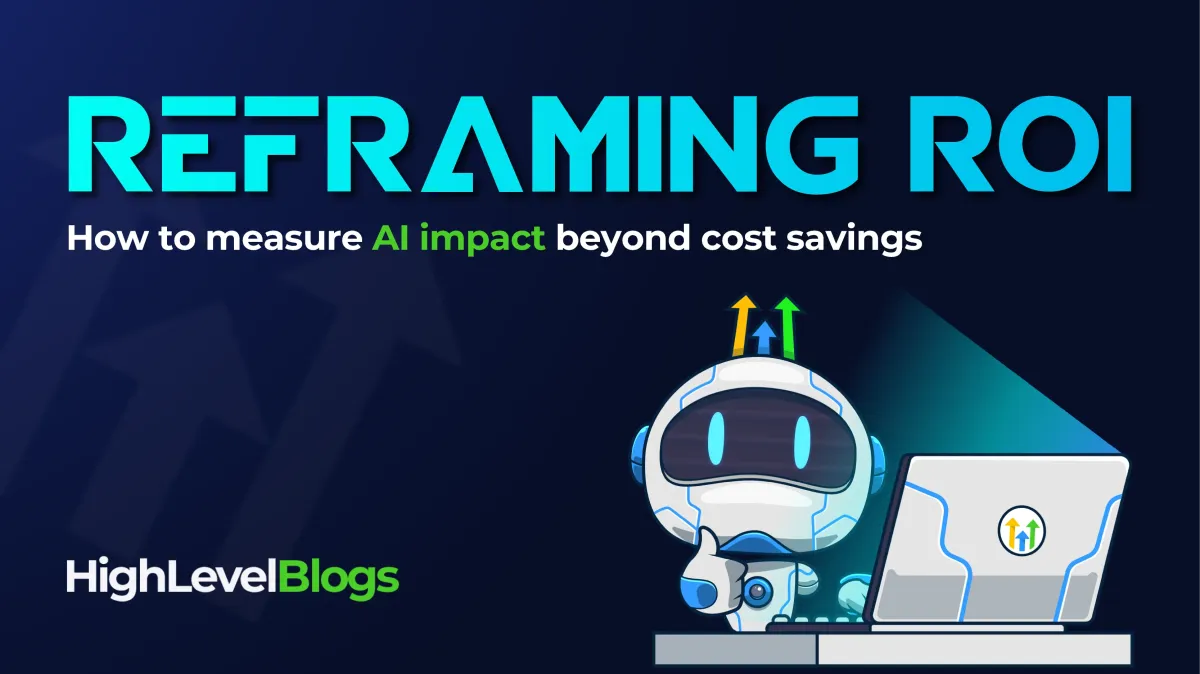
Reframing ROI: How to measure AI impact beyond cost savings
For most businesses, especially smaller teams and agencies, the first conversation around AI usually starts with one question: How much money will it save us?
That’s not a bad question. It makes sense.
AI promises to offload repetitive tasks by answering FAQs, qualifying leads, responding to reviews and more, which often translates to fewer outsourced hours, lower payroll costs or faster turnarounds.
For lean teams, those savings feel tangible.
But here’s the trap: if the only value you’re measuring is how cheap AI makes something, you’ll always underuse it.
AI isn’t just an expense reducer. It’s a capacity expander.
The real value comes when you stop looking at it as a tool to cut corners and start treating it as a strategic layer in your business. One that integrates across your workflows, customer experience, marketing efforts and team operations. One that you invest in, train, measure and optimize the same way you would any essential part of your infrastructure.
This is the shift that unlocks long-term AI ROI: moving from short-term savings to long-term performance.
Let’s take a closer look!
The problem with treating AI only as a cost‑cutter
AI cost‑savings headlines are easy to spot: Morgan Stanley estimates full AI adoption could yield $920 billion in annual labor savings across U.S. firms.
Such figures imply huge efficiency gains, but missing is the deeper business upside: creativity, speed to market, smarter decisions.
Numerous leaders believe AI offers strategic advantage. Propeller found 82 percent of organizations think AI is essential, yet 49 percent of CIOs struggle to demonstrate AI’s value, and 85 percent of large enterprises lack tools to track ROI.
That’s a gap between belief and proof.
Overly simplistic ROI models miss how AI transforms roles and workflows. As reported in a Deloitte-sponsored article, traditional measures of ROI don’t fit generative or agentic AI, these introduce shifts, they generate outputs and influence strategy, not just reduce headcount or save time.
Left unmeasured, AI becomes an unproven novelty rather than a strategic business lever.
New metrics for a new era: What AI success really looks like
We need wider currency than cost savings. A guide from usegen.ai argues that ROI should account for faster decision-making, improved customer experience, innovation potential and long-term strategic differentiation.
Meanwhile, Lleverage.ai outlines a framework covering:
Direct cost savings
Productivity gains
Revenue impact
Risk reduction
Employee experience
Customer experience
They warn that 30‑40 percent of AI initiatives fail because they measure the wrong things.
Then there’s the cultural metric: a Qlik study of UK companies shows only 11 percent report most AI initiatives deliver tangible results, while 44 percent acknowledge a gap between perceived and actual productivity gains.
The remedy? Better internal skills, unified data strategy, and outcome-based KPIs.
In short: strategic ROI models measure outcome, adoption and impact, not just reduction in cost.
From engagement to efficiency: Measuring AI agent productivity
Turning metrics into meaning requires tracking across layers. Imagine:
Time saved per contact or call: Let’s say AI cuts call handling time by 30 percent. Multiply that by volume and you see hours repurposed for client engagement.
Conversion uplift: AI can engage more leads, and studies show AI-driven personalization can boost conversions by up to 20 percent.
Quality improvements: Reducing errors, improving accuracy in messaging. Propeller cites better decision-making and customer satisfaction as long-term value.
Adoption rates: Measure how quickly your team uses AI tools. TechRadar reports 97 percent of analysts use AI and 87 percent rely on automation, making performance tracking easier.
Employee experience: When AI handles grunt work, employee satisfaction and focus on strategy tend to rise. This kind of value rarely makes it into a spreadsheet, but can be tracked via qualitative feedback and turnover metrics.
Each of these defines ROI as strategic impact, not just savings.
How HighLevel helps you track and optimize AI‑driven results
Instead of stitching together analytics tools, HighLevel gives you built-in measurement. Here’s how four key measurement areas come alive:
1. Activity volume and task handling
HighLevel shows how many conversations, calls and lead interactions are handled by your AI agents. Whether it's chat messages on your site or incoming voice calls, you can monitor how much ground AI is covering and use that to estimate the time your team saves.
2. CRM pipeline movement
Because your AI tools are integrated with the CRM, you can see how leads move through the pipeline after AI-driven touchpoints. When the AI books a call, updates a contact tag or triggers a workflow, you’ll see that reflected in your deal stages and velocity metrics.
3. Engagement across channels
AI conversations don’t happen in a vacuum. With HighLevel, you can view activity across SMS, Facebook, Instagram and web chat.
You’ll see where conversations are happening, how customers respond and where AI is playing a role in the follow-up process, all within the same messaging ecosystem.
4. Automation and scalability
HighLevel tools like Reviews AI and Voice AI make it easier to scale quality interactions. Review responses are auto-generated and tracked. Voice AI creates call summaries that capture context and next steps. You can also apply lead scoring rules through workflows to highlight your most engaged contacts.
Together, these insights give you a clear view of how AI supports your team, not just in theory, but in the numbers you already track. You’ll see where AI is reducing manual workload, driving conversations forward and creating more space for human focus.
Conclusion: AI is an investment in scale speed and strategy
AI ROI is all about stronger decisions, faster outcomes, better experience and strategic freedom.
When ROI frameworks include leading indicators, engagement metrics, adoption and outcome alignment, you move from trend-chasing to strategy.
HighLevel ensures AI is measurable, not mysterious. It transforms AI from novelty to a quantifiable driver of growth.
Jump into HighLevel’s Summer of AI
You’ve learned how to measure strategic AI impact. Now see it in action.
HighLevel’s Summer of AI gives you full access to the AI Employee suite, free for 30 days!
Track AI-driven calls, messages, workflows and pipelines. Watch ROI manifest in time saved, pipeline progression and smarter workload distribution.
This offer ends soon. If you're ready to see measurable AI value on your terms, now’s the time.

